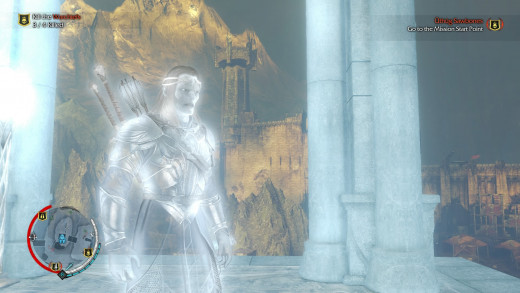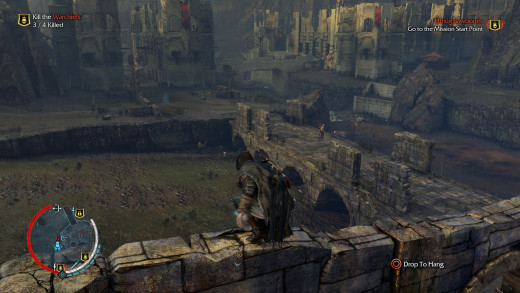Middle Earth: Shadow of Mordor PS4 Review
Shadow Of Mordor - Lord Of The Rings Done Right
Shadow of Mordor (SoM, for short) is one of those rare games, which successfully takes tried and true gaming conventions, then adds to them to become something totally different and fresh.
Not only that, but it is perhaps the first title (in a long list of duds and also-rans) to finally nail the Lord Of The Rings/Middle Earth atmosphere and lore in game form.
This was the promise I read about in countless reviews, from professional journalists and gamers, alike.
As a LOTR fanboy since the age of 10, I was therefore eager to get hold of this game, when I bought my Playstation 4 in the Boxing Day sales.
Now that I have played through about 10 hours+ of the game, I can honestly say that it has met that promise - and then some.
It wasn't like that right from the start, though.

Middle Earth Start Up Blues
In those aforementioned reviews, I had read about how your character is a ranger named Talion.
I also read how his death at the hands of Orcs ties him to a mysterious Elf Wraith, thus setting up the revenge premise of the story.
Oddly, the packaging on the box told me nothing about the game: very little text, no story, two or three screenshots, and no indication at all of what the game was all about.
I would have to rely on information gleaned from the reviews to understand what was going on.
However, I was completely unprepared for how Shadow of Mordor began.
A Shadow Falls On The Black Gate
The game took a while to load on the first run.
The only indication it was doing anything was a small spinning circle in the bottom right corner of the screen.
This took long enough that I began to wonder if I had a duff copy and might need to return it to the shop.
When it did get going, there was a brief movie, which appeared to begin part way through a scene, before a “flash-back" took me to the first, short tutorial.
After that, it alternated between further flash-backs and tutorials, each time with the small spinning circle in between, which took away from the flow of the thing.
These told the story of how our hero lost his family and his own life, but received a second chance.
First reactions were, "what on earth is going on?", followed by, "Ok, that's kind of cool", to "that white circle is really getting on my nerves", and finally, "aha, now I know what's happening!"

Middle Earth As Open World
After the initial tutorial, you are thrown out into the open world of Mordor.
It's not the most massive place (I'm comparing to similar games here), but there's plenty to do and see, in the space that there is.
Like many open world games, you'll see fairly typical elements:
- There is a map with lots of icons to explore
- There are towers (called "forge towers" here), which serve as home base and fast travel points, once unlocked
- There are icons representing story missions and side missions
- Other icons indicate power struggles (see Nemesis system, below)
- Menu options allow you to level up your character and your gear, or read about stuff you've discovered
So far, so obvious, if you've played any other open world game.
OK, I'll get the next bit out the way.
Yes, the exploration and climbing is just like Assassin's Creed, but easier, IMO.
Yes, the combat and stealth is just like Batman Arkham Asylum/City - I'll reserve judgement on whether it is better or not, but in my eyes, if it ain't broke, don't fix it.
And yes, there is a "wraith vision" mode, which works just like the "Eagle vision" of AC or the "detective vision" of Batman.
However, the basics of exploration, combat and stealth work really well together, and it is so easy to flow from one to the other, that you won't even notice.
I hardly ever get stuck on what button to press, and most of that has been me getting used to the PS4 controller, when I previously used an Xbox.

Control The Shadow
Speaking of the controls, I really like how the PS4 controller adds to the experience.
The basics are nice and simple, with square to attack and the X button making your character run.
Hold down L2 (left trigger, if you're not familiar with the PS4) and you go into stealth mode, but can still do a crouched run, if you hold X at the same time - easy and intuitive.
This makes it a piece of cake to seamlessly change from sneaking around, to firing off a couple of arrows, to melee combat and back again, all without breaking a sweat.
At first, I thought the only way to see the map was via the menu option for Sauron's Army, followed by a trigger press, which seemed a bit long-winded.
It took me a while to realise that, in fact, a simple click of the controller touchpad would do the job - much better.
The controller's internal speaker is put to good use, too.
When loading the game to your last checkpoint, you hear the voices of Talion's past come from there, which creates an eerie ambience while you wait to start the game.
Similarly you'll get contextual sounds, such as the rustling of leaves when Talion is hiding in a bush, or a sudden sharp, rising sound when your hero bites the dust.
These sounds are not overused, but I am surprised at how much they add to the immersion.

Shadow Of Mordor Graphics
With a new console, everyone wants to know what the graphics are like.
Our expectations are higher for each new generation and so, we tend to judge them more harshly too.
On the whole, developer Monolith does a good job of utilising the extra power of the PS4, but I don’t think we’ve seen the best they can do yet.
That said, I haven’t seen many games on my PS4, due to the recent purchase, so don’t have much to go on.
For example, I received a copy of The Last of Us Remastered, with my bundle of joy.
Graphically, The Last of Us trumps SoM, despite being an HD remake of a last generation title.
However, the comparison is hardly fair, because The Last of Us is a linear jaunt, while SoM is an open world game, having so much more to deal with on screen, at any given time.
SoM has been criticised for being too brown and dull, which I can understand because, well, it’s Mordor.
However, there is enough variation in the terrain for hills, valleys, damaged fortresses and ruins to dot the landscape.
Where I feel the game shines, is in the characterisation of the Uruk Captains and the animations for the main character.
Due to the evolving nature of the game (see Nemesis system, below), Orcs that are promoted and/or damaged by your actions, change their looks and gear.
For example, an Orc that has “levelled up” may sport better armour and weaponry, while perhaps wearing bandages around their head, due to your last encounter.
The animation for Talion is splendid, particularly the combat finishers, some of which are brutal and earn the game its 18 rating.
The technical changes between combat and stealth, and between the ranger and wraith powers are also impressive, to my eye.
I look forward to improvements in any sequel that may follow on.
Gameplay Video
Thanks to the power of my shiny new Playstation 4, I can now upload videos direct to YouTube.
Below is some example gameplay, right near the start of my play through.
Since I am learning the game at this point, you may see me make some mistakes, but that's all part of the fun.
Don't worry though, there are no story spoilers contained within.
The Nemesis System
Every review has talked about the so called "Nemesis system" that is an integral part of Shadow of Mordor, and I would be remiss not to include my experiences of it.
The idea is deceptively simple: a menu option takes you to a screen, similar in feel to a chess board, which shows the major players in Sauron's army.
At first they will all appear as blank silhouettes, but as you encounter the Captains and Warchiefs in their strongholds, or interrogate lesser Orcs, you will gain more information on them.
Different levels in the Orc army will give you more, or less, information:
- Ordinary grunts will give you the name of a Captain, but nothing more
- Orcs marked with the "intelligence" icon, or separate Intel pickups you find around the world, will tell you their weaknesses and strengths
- Stronger Captains must be interrogated to get the low-down on the War chiefs
If you take advantage of a character’s weakness, then it will help to cancel out their strengths and can mean the difference between life and death.
Thing is, these foes are randomly generated, so no two players will have the same experience.
Again, I had read about all these things already.
However, nothing could prepare me for just how good it is, in practice.

My Personal Nemesis
I am still very much learning my way around the system, but I am beginning to recognise some of the Uruks that are coming my way.
Near the beginning of the game, I picked on the lowest level Orcs and quickly made a swathe of destruction through the horde.
I was beginning to get overconfident though, as I found out to my cost, just last night.
I had finished watching a movie and thought I would pop the game disc in, for a quick half hour romp through Middle Earth.
I started off making a beeline for a duel being fought by Horza Hell-Hawk.
I had met him before a couple of times and while I had defeated him at least once, he first shot to fame when one of his arrows took me down in the middle of a melee.
I had a grudge to nurse and interfering in his internal power struggle seemed like a golden opportunity to get my own back.
I sneaked into the fortress where he was hiding, silently taking out the archers idling around the rooftops, and then I saw him.
I went in for a stealth kill, as I knew he had a weakness to this form of attack, but despite causing lots of damage, he refused to die.
There was nothing for it, but to go all out, using my sword against him and his cronies.
I was doing well and whittled his health down to the point where I could interrogate him.
I grabbed him and got some Intel on a Warchief I previously knew nothing about.
This was beneficial for the long term plan, but afterwards I really wished I had executed the Hell-Hawk on the spot...

Trouble Is Coming
In the moment of his defeat, one of the guards had run for help.
I heard a horn sound nearby and a moment later I was surrounded by Orcs.
Two Captains, one of whom I had never met, charged into the fray.
Foolishly emboldened by my recent victory, I charged back, only to discover that the new Captain and one of his guards had a shield and spear.
The shield prevents direct attacks and the spear has to be dodged - and I am still having trouble getting the timing right on this.
Added to that, a berserker in the crowd meant that I went down in short order.
Annoying.
Even more annoying was the battle report.
This showed that not only did the new Captain get promoted, but Horza was still alive and received a power boost too.
I wasn't going to take that sitting down, so off I headed once more to invade another power struggle involving my Nemesis.
..and then found the same Captain, who had just defeated me, skulking around the area.
I tried to finish him off and got drawn into another melee near my destination.
Then I got shot in the back with a flaming arrow - by that dratted Horza!

Frustration And Elation
This was highly frustrating, but I mean this only in a good way.
In my example, I managed to die 3 times (yes there was another one) in the space of half an hour and each time, my enemies were powering up as a result.
However, that only steeled my resolve to get back at them and I am already plotting their downfall.
I am going to calm down first, then go through some more story missions and try to improve my character a bit.
I will be back for you Horza Hell-Hawk and next time, things will be different!
- And when I do finally succeed in taking that sucker down, I know there will be a moment of real elation.
Maybe I'll even do a (private) lap of honour around the room? *cough*
That's something that is sorely missing from many games these days, but Shadow of Mordor has it in spades.
The story missions are great in their own way and many of the side missions give homage to the Lord of the Rings world and lore.
However, it's these emergent, truly interactive stories that give the game its unique flavour.
It's those moments that I will remember for a long time to come and it’s those moments I will tell my gaming friends about.
The "revenge trope" is a tired, worn out aspect of video game stories, but no other game I know of has managed to weave it into the fabric of how the gamer actually plays, in the way that this one does.
Nor has any other game made revenge quite so personal.
In short, Shadow of Mordor comes highly recommended.
Rating
Leave A Comment
Are you champing at the bit to play Shadow of Mordor?
Are you part way through or finished it?
Let me know if you agree with my assessment of the game, below.
© 2015 Tim Bader









